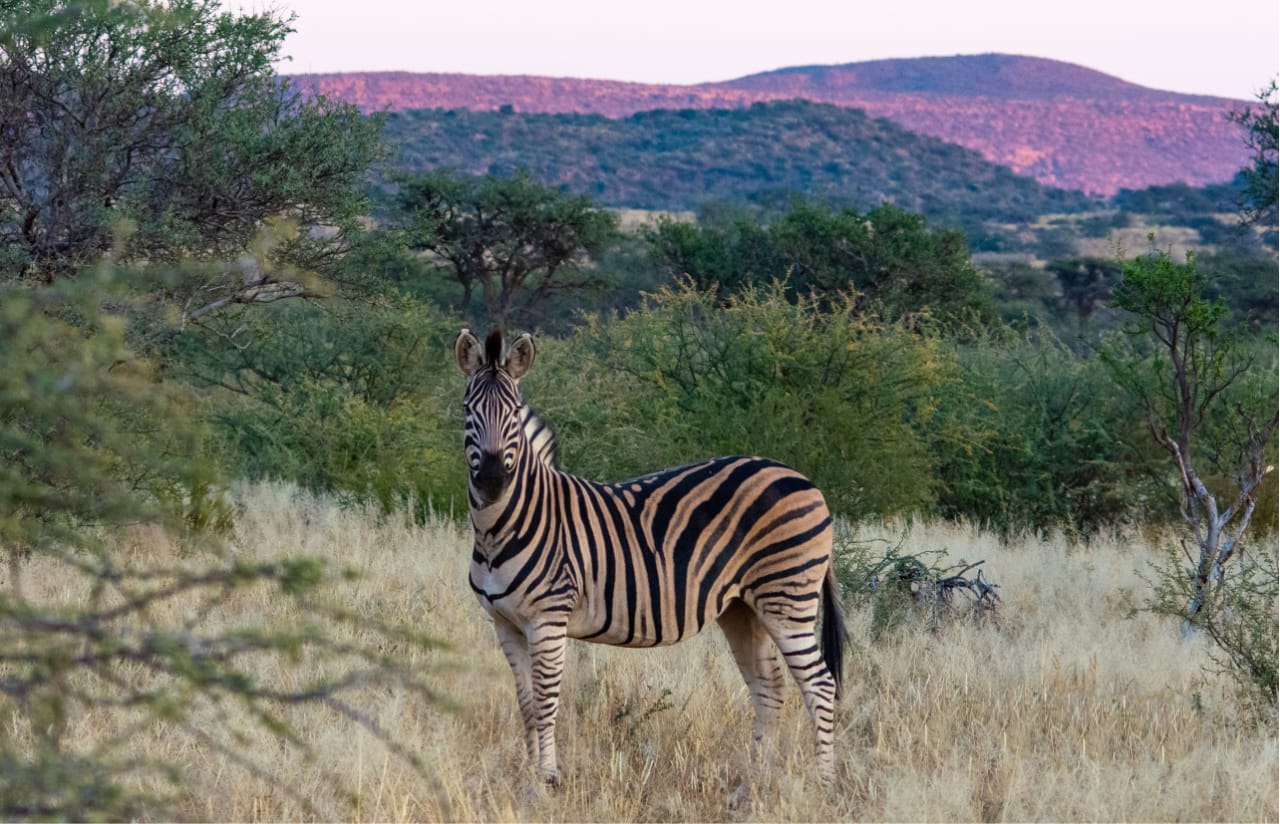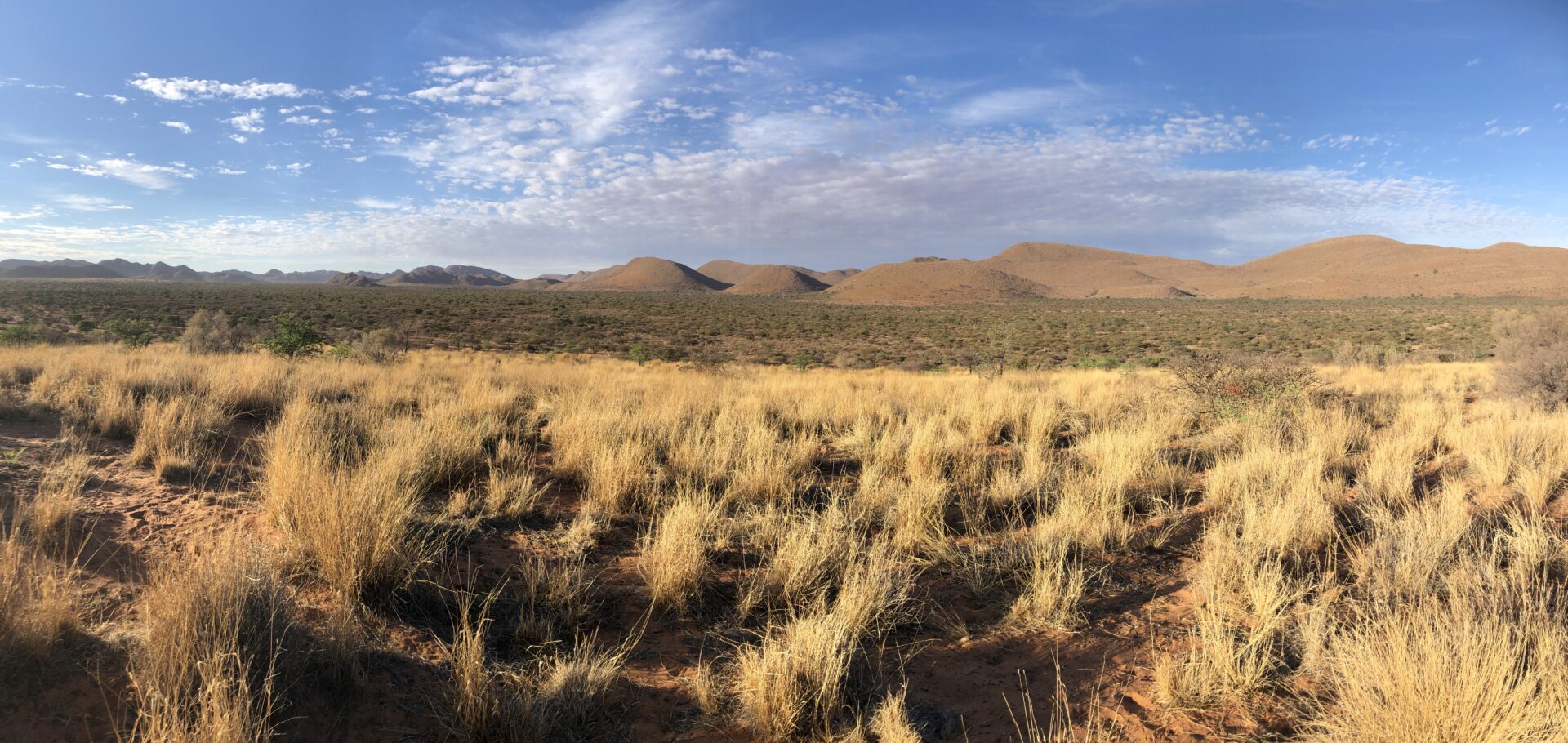DISCOVER OUR KALAHARI
Situated in South Africa’s immense Savanna Biome, Tswalu lies in a transition zone between the true Kalahari ecotype and arid savannah. The undulating dunes of the reserve are punctuated by the Korannaberg mountains, which contribute to greater habitat diversity than anywhere else in the Kalahari. These mountains are a defining feature of the reserve, casting a benevolent shadow over the red dunes and expansive grasslands that roll away to the horizon. Falling within the semi-arid southern Kalahari, the area is often referred to as the green Kalahari.
Bushveld, Plains and Mountain Shrubveld, Duneveld and Calceous Scrubveld are the five distinct habitats that create a mosaic of shelter and food resources to support the rich and fascinating diversity of species that you will see here. Each habitat contributes to the conservation of the entire ecosystem.
The climate varies from extremely dry to slightly wetter, with winter being the dry season and the rain usually falling during the summer months from October to April.
Grasses, shrubs and trees that grow in the savanna have adapted to life with little water and extreme temperatures, and the seasons dictate how each habitat responds to these changes. In years where there is sufficient summer rain, the grasses flourish before turning brown in the dry winter months. After rain, the shrubs and trees flower and some of the bare trees sprout leaves again.
The vegetation of the Savanna Biome is ideal for wildlife grazing. The terrain manifests as vast, unspoilt landscapes of grasslands and undulating dunes of reddish sand that lend a pink tinge to the clouds above. Below the camel thorn, blackthorn, silver cluster-leaf and shepherd’s trees, ground covers and creeping plants, like the yellow devil’s thorn, flourish and burst into bloom after the first rains. Due to the vastness of the reserve, rain is often localised and certain areas may receive more rain and appear greener than others.
In the foothills of the Korannaberg mountains, the Bushveld’s grassy plains are dotted with dense clusters of trees and tall shrubs. Also called the Eastern Kalahari Bushveld, it falls within an area of slightly higher rainfall which is reflected in the vegetation. Flatter than the dune areas, the grassy plains merge with dense tree savanna where camel thorns and shepherd’s trees grow.
Lower growing woody shrubs, such as black thorn and three thorn, are typical of the Plains Shrubveld. These thorny shrubs transform the landscape in spring with prolific displays of white flowers.
Mountain Shrubveld is typical along the Korannaberg range that divides the reserve from north to south. Quartzite rocks are softened by hardy shrubs like lavender fever berry and Karoo yellow thorn with its pom-pom flowers, while evergreen kuni-bush flourishes in between. A typical tree growing here is the Namaqua rock fig.
Parallel to the Korannaberg are the wind-sculpted sands of the Duneveld, consisting of loose Kalahari sand of varying depths. On these shifting sands, special dune grasses cling to the crests of the dunes where the sand is looser and grey camel thorn and silver cluster leaf trees thrive. The streets between the dunes are typically Shrubveld.
Calcrete Scrubveld covers the calcrete soils and pans in the west of the reserve where nutritious grasses and palatable scrub is interspersed with dry and hardy scrub, shepherd’s trees and camel thorns.
In habitat conservation terms, diversity is strength. The more diverse the habitats in an ecosystem, the better the system and species living within that system are able to cope with change. The green Kalahari, with its arid vegetation types, is considered vulnerable to climate change and ongoing monitoring is key to understanding and responding to the conservation and protection of this valuable wilderness area.
READ OUR STORIES
The Habitats of Tswalu
Broadly speaking, Tswalu includes five major habitats that have arisen primarily around the Korannaberg Mountains as a result of the windblown sands that comprise the Kalahari as we know it today.
Tswalu's edible plants
Decent summer rains have the ability to transform Tswalu’s landscapes within a few, short weeks. Then the Green Kalahari earns its name, bursting into life as annual creepers appear, grasses flourish and perennial trees produce fruits that sustain animals and birds.
Studying the impact of climate change
There are few, and possibly no other, studies that have aimed to understand responses of multiple species with an entire ecosystem, making KEEP a unique, ground-breaking project.


